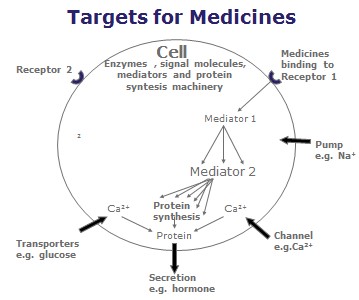Mechanisms of disease
3. Targets for action of medicines
From the descriptions given above it appears that genetic disposition, lifestyle and environmental factors may all influence the development of diseases at many different locations in the body. If we understand the molecular mechanisms behind various diseases (i.e. what has gone wrong at the level of the cells), we can develop medicines that may reverse the harm caused by a disease. This brings us to the question: which molecules in the body are targets for medicines.

Figure 5: a diagram of a cell showing some targets for the actions of natural ligands (see next section ‘Receptors’ for description) and medicines. The cell machinery is made up of signal molecules, enzymes, mediators and molecules for protein synthesis. By activating a few receptors, this can cause a ‘cascade reaction’ (a series of several reactions) inside the cell. The medicine can work with the cell to produce the desired effect. For example, by adding a few medicine molecules, the cell can produce or ‘secrete’ many molecules of the final product (e.g. a hormone). Medicines can also bind to ‘channels’ and ‘pumps’ on the cell surface, to alter how the cell works and what it secretes.